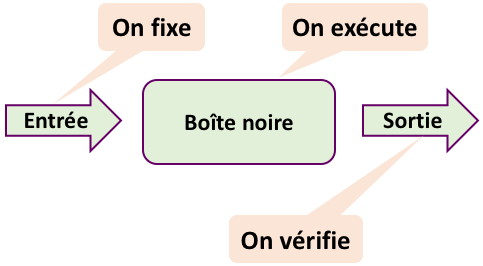Injection
Test unitaire
Unit testing is a software testing method by which individual units of source code […] are tested to determine whether they are fit for use.
— Wikipedia
Protocole de test

Unit ?
One can view a unit as the smallest testable part of an application. In OOP, a unit is often an entire interface, such as a class, but could be an individual method.
— Wikipedia
Problème
public class Car {
public CarStatus start() {
Engine engine = new CarEngine();
if (engine.start()) {
return CarStatus.STARTED;
} else {
return CarStatus.NOT_STARTED;
}
}
}
new
new introduit un couplage fort entre l’appelant et l’appelé
La solution ?

public class Car {
private final Engine engine;
public Car(Engine engine) {
this.engine = engine;
}
public CarStatus start() {
if (engine.start()) {
return CarStatus.STARTED;
} else {
return CarStatus.NOT_STARTED;
}
}
}Création de Car
Car car = new Car(
new CarEngine()
);Contexte de test
public class DummyEngine() extends Engine{
@Override
public boolean start() { return true; }
}
public class Test {
public void shouldStart() {
Car car = new Car(
new DummyEngine()
);
CarStatus status = car.start();
// Check status
}Inversion of Control - IoC
IoC is a design principle in which custom-written portions of a computer program receive the flow of control from a generic framework.
— Wikipedia
IoC en Java/Java EE
Design pattern
Factory
Service Locator
Dependency Injection
Dependency Injection - DI
Dependency injection is a technique whereby one object supplies the dependencies of another object.
— Wikipedia
DI en Java/Java EE
| JSR | Nom | Fonctionnalités |
|---|---|---|
250 | Common Annotations for the Java Platform |
|
330 | Dependency Injection for Java |
|
299 | Java Contexts and Dependency Injection | Décorateurs, intercepteurs, etc. |
@Resource
Injection de ressources du serveur d’apps
Permet de préciser l’emplacement de la ressource
Injection sur le champ
Exemple
@Stateless
public class MyComponent {
@Resource(lookup = "java:comp/env/jdbc/myDataSource")
private DataSource dataSource;
}@Inject
Injection de n’importe quel bean (ou EJB)
Injection par type
Injection via le champ ou le constructeur
Bean
Almost every concrete Java class that has a constructor with no parameters (or a constructor designated with the annotation @Inject) is a bean.
— CDI User guide
Classes "standards"
Activation via fichier
META-INF/beans.xmlCrée un bean pour chaque classe sur le classpath
Scope par défaut
Lié au cycle de vie du bean injecté
@Dependent
Scopes explicites
| Scope | Annotation |
|---|---|
Requête |
|
Session |
|
Application |
|
Injection via le champ
public class Dependency {}
@WebServlet
public class MyServlet extends HttpServlet {
@Inject
private Dependency dependency;
}Note | Aucune possibilité de test unitaire |
Injection via le constructeur
public class Dependency {}
@WebServlet
public class MyServlet extends HttpServlet {
@Inject
public MyServlet(Dependency dependency) {
// Do stuff
}
}Test de l’injection via le constructeur
public class TestDependency extends Dependency {}
public class Test {
public void testServlet() {
Dependency dep = new Dependency();
MyServlet servlet = new MyServlet(dep);
// Test the servlet
}
}Choix du bean injecté

Exemple d’injection ambigüe
public interface Dependency {}
public class DependencyA implements Dependency {}
public class DependencyB implements Dependency {}
@WebServlet
public class MyServlet extends HttpServlet {
@Inject
public MyServlet(Dependency dependency) { }
}javax.enterprise.inject.AmbiguousResolutionException:
There is more than one Bean with type DependencyDésambiguïsation
Injection par nom
Annotation
@Named
public interface Dependency {}
@Named("A")
public class DependencyA implements Dependency {}
public class DependencyB implements Dependency {}
@WebServlet
public class MyServlet extends HttpServlet {
@Inject
public MyServlet(@Named("A") Dependency dep) { }
}Faiblesse
Manque de typage
Basé sur une chaîne de caractères
Possibilité de créer une annotation
Mais toujours une injection par nom
@Qualifier
Permet de restreindre les candidats à l’injection
Via la création d’annotations
@Qualifier @Retention(RUNTIME) @Target({TYPE, PARAMETER})
public @interface ThisOne {}
public interface Dependency {}
@ThisOne
public class DependencyA implements Dependency {}
public class DependencyB implements Dependency {}
@WebServlet
public class MyServlet extends HttpServlet {
@Inject
public MyServlet(@ThisOne Dependency dep) { }
}Méthodes @Produces
Exposer une classe externe (JDK ou librairie) en bean
Exposer un bean dont l’implémentation dépend du contexte
Exposer plusieurs beans avec la même implémentation
Exemple
public interface TaxStrategy {}
public class SwissTaxStrategy implements TaxStrategy {}
public class FrenchTaxStrategy implements TaxStrategy {}
public class TaxStrategyFactory {
@Produces
public TaxStrategy getTaxStrategy() {
if ("ch".equals(Locale.getDefault().getCountry()) {
return new SwissTaxStrategy();
}
return new FrenchTaxStrategy();
}
}
public class TaxComputationServlet {
@Inject private TaxStrategy taxStrategy;
}Concepts avancés
@Alternative
Gérer de la logique métier déterminée à l’exécution
Spécifier des beans pour un scénario de déploiement
Créer des beans utilisés uniquement pour les tests
Principe
Un bean principal (pas annoté)
D’autres beans annotés avec
@Alternative
Configuration du beans.xml
| Bean injecté | Exemple |
|---|---|
Bean principal | |
Bean configuré | |
Initialisation / nettoyage
Possibilité d’exécuter du code :
Juste après l’instanciation
Juste avant la recollection par le ramasse-miettes
Annotations
Sur une méthode :
@PostConstruct@PreDestroy
Contraintes
Une méthode par annotation
Pas d’arguments
Pas d’exception checked
Type de retour
voidMéthode d’instance
Peut être
finalAucune contrainte sur la visibilité
Intercepteurs
An interceptor is a class used to interpose in method invocations or lifecycle events that occur in an associated target class. The interceptor performs tasks, such as logging or auditing, that are separate from the business logic of the application and are repeated often within an application.
— Oracle documentation
Cas d’utilisation d’intercepteur
Tracer l’exécution d’une méthode
Tracer le temps d’exécution d’une méthode
etc.

Création de l’annotation
@InterceptorBinding
@Target({ TYPE, METHOD })
@Retention(RUNTIME)
public @interface Logged { }Création de l’implémentation
@Interceptor
@Logged
public class LoggingInterceptor {
@AroundInvoke
public Object log(InvocationContext ctx) throws Exception {
long start = System.currentTimeMillis();
Object value = ctx.proceed();
System.out.println(
"[" + ctx.getMethod().getName() + "]: " +
(System.currentTimeMillis() - start) + " ms");
return value;
}
}Activation
<beans>
<interceptors>
<class>
ch.frankel.LoggingInterceptor
</class>
</interceptors>
</beans>Utilisation
@Logged
@Stateless
public class FooService {
public void bar() {
}
}Décorateurs
Decorators are outwardly similar to interceptors. However, they actually perform tasks complementary to those performed by interceptors. […] Decorators, on the other hand, do perform business logic by intercepting business methods of beans.
— Oracle documentation
Exemple de décorateur
Appliquer un taux de TVA
Principes
Le décorateur doit implémenter la même interface que le bean décoré
Si plusieurs décorateurs s’appliquent, ils sont invoqués dans l’ordre du
beans.xml
interface HasPrice {
double getPrice();
}public class Product implements HasPrice {
private final String name;
private final double price;
public Product(String name, double price) {
this.name = name;
this.price = price;
}
@Override public double getPrice() {
return price;
}
}@Decorator
public class ProductWithVat implements HasPrice {
private final Product product;
@Inject
public ProductWithVat(@Delegate Product product) {
this.product = product;
}
@Override public double getPrice() {
return product.getPrice() * 1.077;
}
}Programmation évènementielle avec CDI
CDI implémente le pattern Observer
Principes
Injection du générateur d’évènements via CDI
Basé sur le type
Event<T>
Aucune restriction sur le type de l'Observer
Méthode configurée via
@Observe
Aucune restriction sur le type d’évènement
Exemple de code
public class Subject {
private Event<String> event;
@Inject
public Subject(Event<String> event) {
this.event = event;
}
public sendTimestampEvent(String message) {
event.fire("[" + System.currentTimeMillis() + "]: "
+ message);
}
}public class Observer {
public receiveEvent(@Observe String message) {
System.out.println("Received " + message);
}
}Tips & tricks
Il est possible, mais déconseillé, de créer des messages à partir de types simples
Il est possible, mais déconseillé, de créer des annotations pour discriminer les évènements auxquels on veut s’abonner
Il est conseillé de plutôt créer des types dédiés